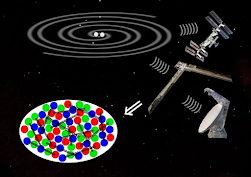
Requiring consistency between the physics of neutron stars and quark matter leads to the first astrophysical constraint on this exotic phase of matter.
Recent research uses neutron star measurements to place empirical limits on the strength of color superconducting pairing in quark matter, revealing new insights into the physics of the densest visible matter in the universe through astronomical observations.
Color Superconductivity
At extremely high densities, quarks are expected to pair up, much like electrons in a superconductor. This phenomenon, known as color superconductivity, occurs under extreme conditions. Calculating the strength of these quark pairings is challenging, but scientists have long understood its relationship to the pressure within dense matter. By measuring the size of neutron stars and how they deform during mergers, researchers can estimate their internal pressures, confirming that neutron stars are the densest visible matter in the universe.
In this study, researchers analyzed observations of neutron stars to infer properties of quark matter at even higher densities, where color superconductivity is certain to occur. Their work provides the first empirical upper limit on the strength of color superconducting pairing.
Empirical Insights From Neutron Stars
While color superconductivity has been a focus of theoretical physicists for over two decades, this study is the first to use data from neutron stars to establish empirical constraints on pairing strength. This breakthrough opens a new frontier in understanding quark matter through astrophysical observations of neutron stars.

Data-Driven Analysis of Quark Matter
Measurements from NICER, LIGO/Virgo, and ground-based radio telescopes provide insight into the pressures and densities at the cores of various neutron stars, each with some uncertainty.
In this study, scientists performed a statistical analysis of these measurements to extract a range of possible pressures at quark-matter densities. Scientists know what the pressure of quark matter at these high densities would be without considering quark pairing, so the range of possible deviation from that baseline provided this study’s researchers with the range of pairing effects that are consistent with the neutron star observations.
This allowed the researchers to extract empirical bounds on the strength of color superconducting pairing.
Website: International Research Awards on High Energy Physics and Computational Science.
#HighEnergyPhysics#ParticlePhysics#QuantumPhysics#AstroparticlePhysics#ColliderPhysics#HiggsBoson#LHC#QuantumFieldTheory#NeutrinoPhysics#PhysicsResearch#ComputationalScience#DataScience#ScientificComputing#NumericalMethods#HighPerformanceComputing#MachineLearningInScience#BigData#AlgorithmDevelopment#SimulationScience#ParallelComputing
Visit Our Website : hep-conferences.sciencefather.com
Nomination Link : https://hep-conferences.sciencefather.com/award-nomination/?ecategory=Awards&rcategory=Awardee
Registration Link : hep-conferences.sciencefather.com/award-registration/
Member Link : hep-conferences.sciencefather.com/conference-membership/?ecategory=Membership&rcategory=Member
Awards-Winners : hep-conferences.sciencefather.com/awards-winners/
Contact us : contact@sciencefather.com
Get Connected Here:
==================
Social Media Link
Twitter : x.com/Psciencefather
Pinterest : in.pinterest.com/physicsresearchorganisation
Blog : physicscience23.blogspot.com
Instagram : www.instagram.com/victoriaanisa1
YouTube :www.youtube.com/channel/UCzqmZ9z40uRjiPSr9XdEwMA
Comments
Post a Comment